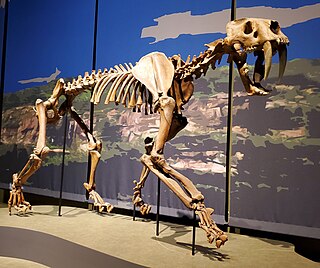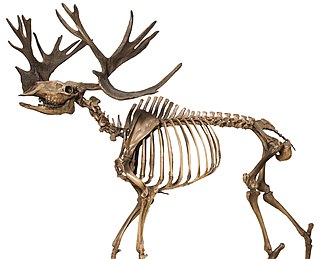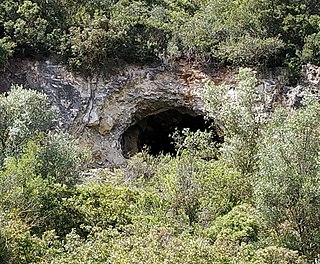Related Research Articles

The moose or elk is the only species in the genus Alces. It is the largest and heaviest extant species of deer. Most adult male moose have distinctive broad, palmate antlers; most other members of the deer family have antlers with a dendritic ("twig-like") configuration. Moose typically inhabit boreal forests and temperate broadleaf and mixed forests of the Northern Hemisphere in temperate to subarctic climates. Hunting and other human activities have caused a reduction in the size of the moose's range over time. It has been reintroduced to some of its former habitats. Currently, most moose occur in Canada, Alaska, New England, New York State, Fennoscandia, the Baltic states, Poland, Kazakhstan, and Russia.

Smilodon is a genus of felids belonging to the extinct subfamily Machairodontinae. It is one of the best known saber-toothed predators and prehistoric mammals. Although commonly known as the saber-toothed tiger, it was not closely related to the tiger or other modern cats. Smilodon lived in the Americas during the Pleistocene epoch. The genus was named in 1842 based on fossils from Brazil; the generic name means "scalpel" or "two-edged knife" combined with "tooth". Three species are recognized today: S. gracilis, S. fatalis, and S. populator. The two latter species were probably descended from S. gracilis, which itself probably evolved from Megantereon. The hundreds of specimens obtained from the La Brea Tar Pits in Los Angeles constitute the largest collection of Smilodon fossils.

Homotherium is an extinct genus of machairodontine scimitar-toothed cat that inhabited North America, South America, Eurasia, and Africa during the Pliocene and Pleistocene epochs from around 4 million to 12,000 years ago. In comparison to Smilodon, the canines of Homotherium were shorter, and it was probably adapted to running down rather than ambushing prey.

The La Brea Tar Pits is an active paleontological research site in urban Los Angeles. Hancock Park was formed around a group of tar pits where natural asphalt has seeped up from the ground for tens of thousands of years. Over many centuries, the bones of trapped animals have been preserved. The George C. Page Museum is dedicated to researching the tar pits and displaying specimens from the animals that died there. La Brea Tar Pits is a registered National Natural Landmark.

Big Bone Lick State Park is located at Big Bone in Boone County, Kentucky. The name of the park comes from the Pleistocene megafauna fossils found there. Mammoths are believed to have been drawn to this location by a salt lick deposited around the sulfur springs. Other animals including forms of bison, caribou, deer, elk, horse, mastodon, moose, musk ox, peccary, ground sloths, wolves, black bears, stag moose, saber-toothed cats, and possibly tapir also grazed the vegetation and salty earth around the springs that the animals relied on for their diet.

The Irish elk, also called the giant deer or Irish deer, is an extinct species of deer in the genus Megaloceros and is one of the largest deer that ever lived. Its range extended across Eurasia during the Pleistocene, from Ireland to Lake Baikal in Siberia. The most recent remains of the species have been radiocarbon dated to about 7,700 years ago in western Russia.

Machairodontinae is an extinct subfamily of carnivoran mammals of the family Felidae. They were found in Asia, Africa, North America, South America, and Europe from the Miocene to the Pleistocene, living from about 16 million until about 11,000 years ago.

UBS Tower is a 108-meter (354-foot), 28-story skyscraper at 315 Deaderick Street in Nashville, Tennessee.

Xenosmilus hodsonae is an extinct species of the Machairodontinae, or saber-toothed cats.

Cueva del Milodón Natural Monument is a Natural Monument located in the Chilean Patagonia, 24 km (15 mi) northwest of Puerto Natales and 270 km (168 mi) north of Punta Arenas.

Cervalces scotti, also known as stag-moose, is an extinct species of large deer that lived in North America during the Late Pleistocene epoch. It is the only known North American member of the genus Cervalces. Its closest living relative is the modern moose.
Spring Valley Caverns is a cave system in southeastern Minnesota near Spring Valley, Minnesota in Fillmore County. The region is within the Driftless Area, a region noted for its karst topography, which includes caves and sinkholes.
Machairodontini is an extinct tribe of large saber-toothed cats of the subfamily Machairodontinae, that lived in Europe, Asia, Africa, and North America, during the Middle and Late Miocene.

The First American Cave is an archaeological and palentological site in downtown Nashville, Davidson County, Tennessee. The site was initially recognized in 1971 during construction of the foundations for the First American National Bank building at 315 Deaderick Street, when workers noticed a collection of bones being unearthed within a pocket of dirt approximately 30 feet below ground surface. Excavations were halted and both the Vanderbilt University Department of Anthropology and the Southeastern Indian Antiquities Survey were notified of the find. It was subsequently determined that the bones included those of humans, as well as a number of animal species, including a saber-tooth cat. The dirt pocket from which the bones had been disinterred was in fact a filled in cave, most of which had been destroyed by construction. The Southeastern Indian Antiquities Survey was given permission to excavate within the remaining portion of the cave with the assistance of Vanderbilt University students.

The Yukon Beringia Interpretive Centre is a research and exhibition facility located at km 1423 on the Alaska Highway in Whitehorse, Yukon, which opened in 1997. The focus of the interpretive centre is the story of Beringia, the 3200 km landmass stretching from the Kolyma River in Siberia to the MacKenzie River in Canada, which remained non-glaciated during the Pleistocene due to light snowfall from an arid climate. Beringia is of special interest to archeologists and paleontologists as it played a crucial role in the migrations of many animals and humans between Asia and the Americas. The term Beringia was first coined by the Swedish botanist Eric Hultén in 1937.

Paleontology in Nebraska refers to paleontological research occurring within or conducted by people from the U.S. state of Nebraska. Nebraska is world-famous as a source of fossils. During the early Paleozoic, Nebraska was covered by a shallow sea that was probably home to creatures like brachiopods, corals, and trilobites. During the Carboniferous, a swampy system of river deltas expanded westward across the state. During the Permian period, the state continued to be mostly dry land. The Triassic and Jurassic are missing from the local rock record, but evidence suggests that during the Cretaceous the state was covered by the Western Interior Seaway, where ammonites, fish, sea turtles, and plesiosaurs swam. The coasts of this sea were home to flowers and dinosaurs. During the early Cenozoic, the sea withdrew and the state was home to mammals like camels and rhinoceros. Ice Age Nebraska was subject to glacial activity and home to creatures like the giant bear Arctodus, horses, mammoths, mastodon, shovel-tusked proboscideans, and Saber-toothed cats. Local Native Americans devised mythical explanations for fossils like attributing them to water monsters killed by their enemies, the thunderbirds. After formally trained scientists began investigating local fossils, major finds like the Agate Springs mammal bone beds occurred. The Pleistocene mammoths Mammuthus primigenius, Mammuthus columbi, and Mammuthus imperator are the Nebraska state fossils.

Cervalces latifrons, the broad-fronted moose, or the giant moose was a giant species of deer that inhabited the Europe and Asia during the Pleistocene epoch. It is thought to be the ancestor of the modern moose, as well as the extinct North American Cervalces scotti. It was considerably larger than living moose, placing it as one of the largest deer to have ever lived.

The Cave of Pedra Furada is a small cave located in the municipality of Vila Franca de Xira, about 20 km north of Lisbon in Portugal. Archaeological studies conducted within the cave suggest it was occupied intermittently by humans during at least three periods between the end of the fourth millennium BC and the second millennium BC. The cave results from karstification of the limestone Upper Jurassic Massif.
Sheriden Cave is a Paleo-Indian archaeological site from the late Ice age in Wyandot County, Ohio. Glacial deposits sealed off the cave more than 10,000 years ago. Sheriden Cave is a karst sinkhole on a dolomite ridge that crosses Hancock and Wyandot Counties. It is associated with the Indian Trail Caverns that opened in 1927. Sheriden Cave was discovered in 1989. The cave is unique because in addition to stone tools, there were also bone tools, remains of extinct animals, and organic matter found in the cave. Radiocarbon dating of artifacts indicate that they were used 11,000 and 12,000 years ago.
Taowu is an extinct genus of machairodonts, a type of saber-toothed cat. It lived during the Early Pleistocene about 2.5 million years ago in East Asia. So far, only one skull is known, found in northern China. Based on this, a relatively small representative of the saber-toothed cats can be reconstructed, which only reached the size of a present-day leopard. In its dentition characteristics, it mediates between phylogenetic older forms such as Amphimachairodus and younger members such as Homotherium. The genus was scientifically described in 2022, but the find material was recovered as early as the 1930s.
References
- ↑ "Tyson's Spring Cave". Minnesota Cave Preserve. Retrieved 17 March 2014.
- ↑ Gulden, Bob. "USA Longest Caves". NSS Geo2. Retrieved 17 March 2014.
- 1 2 "Tyson Spring Cave History Timeline". Minnesota Cave Preserve. Retrieved 17 March 2014.
- 1 2 3 Ackerman, John. "The story of our amazing discoveries. 2008-2009". Minnesota Cave Preserve. Retrieved 17 March 2014.
- ↑ Mather, David. "A new Twist in Megafauna History". Minnesota Department of Natural Resources. Archived from the original on 19 March 2014. Retrieved 17 March 2014.
- 1 2 3 "Homotherium serum and Cervalces from the Great Lakes Region, USA: geochronology, morphology and ancient DNA" (PDF). Boreas. Retrieved 17 March 2014.
- ↑ Meryhew, Richard. "Uncovered Bones are a Hot Find from the Ice Age". Star Tribune. Archived from the original on 19 March 2014. Retrieved 17 March 2014.
- ↑ Switek, Brian. "Genetic Clues from Sabercat Bones". National Geographic. Retrieved 17 March 2014.